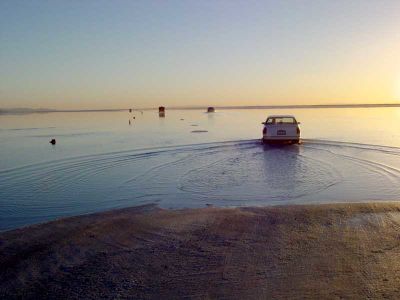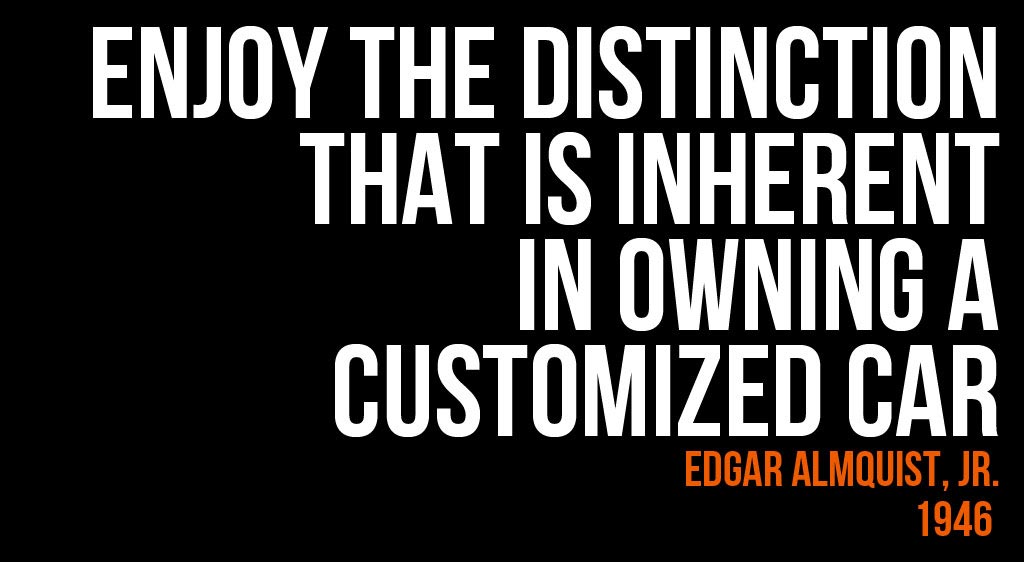Bonneville Salt Flats



The Bonneville Salt Flats (also known as the Salduro Salt Marsh) is a remnant of prehistoric Lake Bonneville [1], named after General Benjamin Bonneville [2] who explored the area in the early 19th century. Its area varies, but is usually stated to be 159 square miles (412 km.) It is located in northwestern Utah [3], near the town of Wendover[4]. It was formed when Lake Bonneville receded, leaving only the mineral deposits comprised of salt compounds of sodium, potassium, calcium and other elements.
The thickness of the salt crust varies from 6 feet (1.8 m) to less than an inch (2.5 cm.) The crust lies over a much thicker stratum of clay-like mud. Its thickness also varies, depending on the underlying bedrock and aquifers. It is the largest of many similar salt flats located west of the Great Salt Lake.
Land Speed Racing
The salt flats have been used as a venue for speed trials since 1914 when Teddy Tezlaff drove his Blitzen Benz to a top speed of 141.73 mph.[1]
In 1932 Ab Jenkins removed the fenders and windshield from a Pierce-Arrow V-12 roadster, and without factory sanction, drove around the ten mile diameter track at the Bonneville Salt Flats for 24 hours. He averaged at 112.93 mph, setting a new record, but it remained unofficial because of a dispute between driver, manufacturer and the AAA board. In 1933, Jenkins returned to the salt as a special consultant on high speed performance for Pierce Arrow. He encouraged the factory to bore the V-12 to 3 1/2", giving it a displacement of 462 ci. He bought a new V-12 convertible coupe that was specially geared for top end. Driving it around the same ten mile track for 24 hours, Jenkins turned an average speed of 177.77 mph. This meet was sanctioned by AAA, and it recorded that he broke 66 American and 14 world stock car records. Jenkins, who later became mayor of Salt Lake City, wanted to promote the salt as a speed course superior to Daytona Beach, and used his own money to make a three reel film of his 1932-1933 speed runs. Jenkins sent copies to Sir Malcolm Campbell and Reid Railton, who were known as the British speed kings. In 1934 the British invaded the salt. Record attempts were made by Campbell, Railton, John Cobb and Captain G.E.T. Eyston. When Cobb set a world record of 352 mph, Eyston drove 357 mph hours later and broke it. Suddenly speed was in the air, and Bonneville had become the center of straight line record attempts.[2]
Land Speed Racing (LSR [5]) began earnest in 1949 when the Southern California Timing Association (SCTA) organized the first annual Speed Week.[6]
Salt Surface
The smooth surface of the Salt Flats is created by flooding which occurs in the winter and spring, then drying through evaporation in the summer months. Some years evaporation does not fully dry the entire area of the salt flats. Sometimes LSR events are canceled because of standing water on the salt surface; at other times the race course my be dry, but the access route from the point where the paved road (known as 'Lands End') stops can be under as much as 2 feet (61 cm) of water.
Save The Salt
In the 1960s the condition of the salt flats began to deteriorate, necessitating shorter race courses. The deterioration was found to be a result of potash refining operations located south of I-18. In th 1980s an organization called Save The Salt [7] was formed to reverse the effects on the salt flats. In 1997 an agreement was reached with the US Bureau of Land Management, Reilly Industries and the Save The Salt organization which led to the pumping of brine from the potash plants (after the potash had been recovered) onto the surface of the flats. Approximately 1.5 million tons (1360777110 kg) have been pumped back onth the salt flats every year (except for 2004 when no pumping was done.) As a result, there has been a noticeable difference in the thickness and durability of the salt crust and courses as long as 11 miles (17.7 km) have been made possible.
References
Links
Bonneville Salt Flats Wikipedia article
Southern California Timing Association {SCTA)
Utah Salt Flats Racing Association (USFRA)
Sources
http://en.wikipedia.org/wiki/Bonneville_Salt_Flats
http://en.wikipedia.org/wiki/Lake_Bonneville
http://en.wikipedia.org/wiki/Benjamin_Bonneville
Bonneville Salt Flats/Utah Motorsports The University of Utah
Land Speed Racing on the Bonneville Salt Flats
http://en.wikipedia.org/wiki/Utah
http://en.wikipedia.org/wiki/Wendover,_UT
http://en.wikipedia.org/wiki/Bonneville_Speedway
http://www.saltflats.com/save%20the%20salt.html
Did you enjoy this article?
Kustomrama is an encyclopedia dedicated to preserve, share and protect traditional hot rod and custom car history from all over the world.
- Help us keep history alive. For as little as 2.99 USD a month you can become a monthly supporter. Click here to learn more.
- Subscribe to our free newsletter and receive regular updates and stories from Kustomrama.
- Do you know someone who would enjoy this article? Click here to forward it.
Can you help us make this article better?
Please get in touch with us at mail@kustomrama.com if you have additional information or photos to share about Bonneville Salt Flats.
This article was made possible by:
SunTec Auto Glass - Auto Glass Services on Vintage and Classic Cars
Finding a replacement windshield, back or side glass can be a difficult task when restoring your vintage or custom classic car. It doesn't have to be though now with auto glass specialist companies like www.suntecautoglass.com. They can source OEM or OEM-equivalent glass for older makes/models; which will ensure a proper fit every time. Check them out for more details!
Do you want to see your company here? Click here for more info about how you can advertise your business on Kustomrama.





